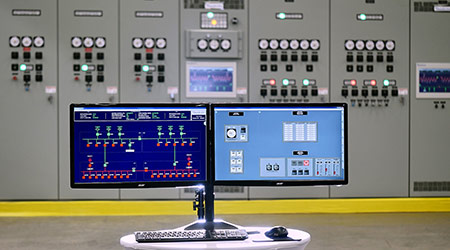Rex Hospital, in Raleigh, N.C., has upgraded its backup power system, ensuring the seamless delivery of both normal and emergency power to all its existing loads – as well as those anticipated by growth over the next several decades, with the addition of a powerful supervisory control and data acquisition (SCADA) system from Russelectric. Customized to the hospital’s unique load profile and specific needs, the system provides Rex with significant increases in reliability, redundancy, and flexibility.
Hospital seeks reliable system with superior equipment
Rex Hospital, the flagship of not-for-profit Rex Healthcare, treats tens of thousands of inpatients every year. The staff includes more than 2,000 physicians and nurses, who also provide services at affiliated clinics and other facilities throughout the surrounding area.
As its facility continued to expand, Rex looked to upgrade its existing open transition power system design, which included an interruption of service during the transition between utility power and generator power. The system also relied on generators and fuel tanks on flatbed trucks to provide additional capacity during construction or when adequate power could not be delivered to the hospital load.
Facility services director Mike Raynor proposed a fail-safe, closed transition system that would allow for a transfer between utility and generator sources without interruption of power to the hospital (which is a more costly approach to open transition systems where additional power interruptions can happen on retransfers). Said Raynor, “People would have noticed a difference if the power went out or came back on, like when there is an outage at your house. There is just no need for a hospital to go through that in this day and age.”
“It would have taken us back many years,” agreed Raynor’s longtime engineering consultant, Travis Jackson. “We like closed transition, and we already had the capability to do paralleling and load curtailment. We certainly didn’t want to give those up.”
The team understood the advantages of the closed transition design and convinced management that the slightly higher first cost of a closed transition system would deliver cost savings over the life of the system and would be well worth the investment over the long term. They successfully presented their case to the hospital’s executives, medical staff, and regulatory officials.
New system offers greater reliability, more redundancy and increased flexibility
The design implemented meant replacing the utility substation and making it more reliable, as well as relocating the switches and switchgear from cramped quarters in the main hospital building to a newly constructed central energy plant. The entire project and system switchover was completed with only a single, planned 10-second outage.
The new comprehensive power system provides the hospital with more reliability, more redundancy, and more flexibility. The plan takes anticipated growth into account, with enough emergency capacity (8.25 megawatt) to handle a proposed 7-story heart center and future cancer center addition.
Rex uses an N+1 arrangement – which means it can take one generator out of service and still retain adequate capacity. The plan replaced three 1.25 MW generators with two Caterpillar 3MW generators, and kept an existing Caterpillar 2.25 MW generator. There is room to add more switchgear and circuit breakers. An automatic transfer switch and an uninterruptible power system have been added to protect the hospital’s data center.
There are two 40,000 gallon underground fuel tanks, and the system maintains fuel in each generator’s emergency 150-gallon “day tank” at all times. Fuel capacity for the previous system was 60,000 gallons – one-third less than the new system. With all tanks full, the hospital could meet its own peak demand (about 5,200 kW) for almost six days. However, since that peak is reached only for short periods on the warmest summer days, the hospital could probably operate under its own power for more than nine days for much of the year.
The hospital’s new substation consists of four utility-owned, pad mounted 2,500 kilovolt-amp (kVA) paralleled transformers providing a total utility capacity of 10,000 kVA (10 mVA). The hospital assumes ownership at the transformer secondaries, which are connected to the hospital’s outdoor switchgear. When an outage occurs, the switchgear automatically disconnects from the utility by opening four 1,200 amp circuit breakers, and simultaneously sends a signal to start the generators.
Based on its present peak load, the hospital can continue to operate without interruption should there be a loss of one transformer. If two or more utility transformers were lost, the hospital’s generators will start and parallel while the outdoor switchgear disconnects from the utility system. The hospital will then remain on the generator source until the utility source is restored, at which time the generators will parallel with the recovered source. Once the utility voltage has stabilized, it will reconnect to the hospital load without interruption.
The utility’s transformer primaries are served by two 25 kV utility feeders from separate distribution systems. Though both are energized, the hospital can draw from only one at a time. If the active feeder is lost, the utility can manually switch the hospital to the backup 25 kV source at the hospital’s substation.
New SCADA system enables monitoring and control
Another important feature of Rex Hospital’s comprehensive power system is the SCADA system, designed by Russelectric. Based in Hingham, Massachusetts, Russelectric develops systems that can provide sophisticated control functions, including emergency/standby power, peak shaving, load curtailment, utility paralleling, cogeneration, and prime power.
The SCADA system includes software and screen displays customized for the hospital’s needs. It provides interactive monitoring, real-time and historical trending, distributed networking, alarm management, and comprehensive reports around the clock for every detail of the entire power system, not only the backup components.
With this system, technicians can fully monitor and control the entire power system from the control room at the central agency plant. An operator uses full-color “point and click” computer-screen displays at the system console to access and change the system’s PLC setpoints, display any of the analog or digital readouts on switchgear front panels, run a system test, or view the alarm history. A dynamic one-line diagram display uses color to indicate the status of the system, including the positions of all power switching devices. Operating parameters are displayed and updated in real time; flashing lights on the switchgear annunciator panel also flash on the SCADA screen. The system also includes event logging, alarm locking, and help screens.
The system allows the scheduling of tests and automatically generates regular reports required by the Joint Commission on the Accreditation of Healthcare Organizations. In the event of an internal failure, the SCADA system can rapidly and automatically configure a path to bypass the failure and re-energize the system without starting the generators.
The SCADA system’s full manual backup was another key advantage. If the touchscreen fails, operating personnel can manually open and close breakers, synchronize and parallel the generators onto the bus, and add or shed load. Other manufacturers’ systems do not provide for full manual operation.
The SCADA system includes a simulator that shows trainees what to expect when they lose a feed, open or close a breaker, or add or remove load. The simulator uses the same control logic software as the switchgear’s programmable logic controllers. The crew also uses the simulator during startup and for trouble-shooting, system improvements, preview testing, and tours.
According to Raynor, Russelectric was the only supplier that could meet his team’s specifications. “A project like this requires a high level of support service and time to get a reliable, yet flexible system. None of the other competitors was willing to step up.” Consulting engineer Travis Jackson, PE, agrees, adding that the Russelectric equipment has welded construction and is sturdy, durable, and extremely reliable.
New system enables peak shaving
The new system enables the hospital to do peak shaving, supplying some of the hospital’s power while the utility is supplying the rest, thereby saving on utility demand charges. The system does not contribute power to the grid, but its load curtailment capabilities means it can respond quickly if the utility asks the hospital to reduce demand on the grid by a specified amount. The resulting contractual rebates lower the hospital’s overall energy costs. For example, if the utility experiences an unusually high demand for power for air conditioning during a heat wave, under their contract they may ask the hospital to generate its own power for a specified amount of time. On average this type of request happens only once or twice per year.
Summing it all up
Commenting on the success of the project, facility services director Raynor said, “The hospital needed a new and modern system that built on what we had already. Working closely with Russelectric, we came up with a very sophisticated system, and we’re at a point now where the system is functioning as we expected ― all the hospital’s electrical needs are covered.”

 Healthcare Is the New Retail
Healthcare Is the New Retail Bridgeway Behavioral Health Services Launches Campaign to Renovate Health Center
Bridgeway Behavioral Health Services Launches Campaign to Renovate Health Center Ground Broken for New North Dakota State Hospital
Ground Broken for New North Dakota State Hospital AI Usage for Healthcare Facilities
AI Usage for Healthcare Facilities Ground Broken on Pelican Valley Senior Living Modernization Project
Ground Broken on Pelican Valley Senior Living Modernization Project